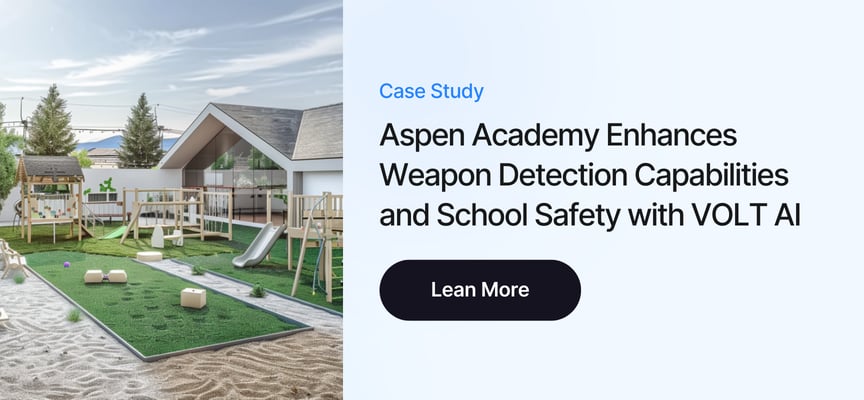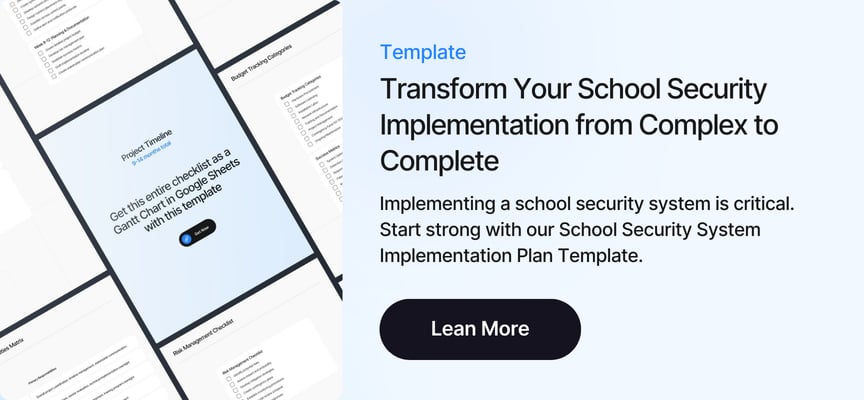Security cameras for schools typically cost between $20,000 and $100,000+ for new system installations, but these figures rarely reflect the complete financial picture. Many schools now discover that AI-powered security camera software integration transforms existing cameras at a fraction of hardware replacement costs, often costing less than hiring a single security employee while delivering comprehensive 24/7 threat detection and response capabilities.
Key Points
- Cost Reality: New school security camera systems typically range from $20,000 for basic installations to over $100,000 for comprehensive campus coverage, but these figures rarely include the full financial picture.
- Hidden Expenses: Camera installation costs including downtime, staff training, infrastructure upgrades, and ongoing maintenance add 30-50% to initial replacement costs, creating budget surprises that derail security projects.
- AI Integration Alternative: Transforming existing security cameras with AI software eliminates hardware replacement costs while delivering advanced threat detection, with some schools spending less than the cost of a single full-time security employee.
- The Aspen Academy Discovery: This Denver-area school found that AI-powered security software cost less than hiring one security employee while providing comprehensive 24/7 coverage across their entire campus.
- ROI Framework: Schools can evaluate true costs by comparing total ownership expenses against software integration that works with existing infrastructure and delivers measurable security improvements.
The Real Question Schools Should Be Asking
School administrators face mounting pressure to enhance campus security. When security concerns arise, the instinctive response often involves replacing outdated camera systems with newer technology.
But what if you're asking the wrong question entirely? Instead of "How much do security cameras cost for schools?" the more strategic inquiry becomes "What's the most cost-effective way to transform our existing security infrastructure into an intelligent safety system?"
The distinction matters because it fundamentally changes your budget calculations, implementation timeline, and ultimately, the safety outcomes modern school security technology can achieve.
Understanding whether to integrate new capabilities with existing cameras or replace entire systems requires comprehensive cost analysis that goes far beyond initial price tags.
Breaking Down New Camera System Costs
Understanding the true cost of security camera installation requires looking beyond the price tags vendors quote. Schools need comprehensive analysis that accounts for every expense associated with bringing new hardware online.
Hardware Investment Range
School security camera costs vary dramatically based on school size and coverage requirements. Basic security camera systems for small schools start around $20,000 to $40,000 for essential coverage. Mid-sized schools with 500-1,000 students usually require investments of $40,000 to $75,000 for adequate monitoring. Large schools and multi-campus districts regularly exceed $100,000 for comprehensive video surveillance installations.
Individual camera costs range from $500 to $1,000 for standard resolution cameras sufficient for basic school applications. High-resolution cameras can cost as much as $8,000 per camera. Most schools require multiple cameras to provide adequate security coverage, with full systems for smaller elementary schools costing $20,000 to $30,000, while projects at large high schools with extensive grounds can reach $200,000.
Installation Expenses That Catch Schools Off Guard
Camera installation costs frequently surprise administrators who focused solely on equipment pricing. Professional installation typically adds 25-40% to hardware costs for running cables, mounting equipment, and configuring network infrastructure.
Schools with older buildings face particular challenges. Historic structures or facilities without modern wiring infrastructure require extensive retrofitting that can double projected installation expenses. Network infrastructure upgrades present another hidden cost, with improvements adding $10,000 to $30,000 to project totals.
The Downtime Factor Nobody Discusses
Installation creates operational disruptions that carry real costs. Security camera installation in active school buildings requires careful scheduling around classes and events. Security gaps emerge during the transition period when schools remove old cameras before new systems go live. This vulnerability period can last several weeks as installers complete work across multiple buildings.
Training Costs That Multiply Quickly
New camera systems require comprehensive staff training that extends beyond security personnel. Administrators need access to review footage. School resource officers require training on system operation to effectively respond to detected threats. Initial training sessions typically cost $2,000 to $5,000 depending on system complexity. Ongoing training needs persist as staff turnover occurs and system updates introduce new features.
Maintenance and Support Agreements
CCTV systems and IP cameras require ongoing maintenance that creates perpetual budget obligations. Annual maintenance contracts typically cost 12-18% of initial system investment. Equipment failures happen regardless of quality, requiring budget reserves for unexpected repairs. System obsolescence creates replacement cycles, with security camera systems often requiring significant upgrades within 5-7 years.
The AI Security Camera Software Integration Alternative
Schools exploring alternatives to complete camera replacement discover a fundamentally different approach. AI security camera software integration transforms existing cameras into intelligent security systems without requiring hardware replacement.
Read the full guide on security cameras for schools.
What AI Integration Actually Means
AI security camera software integration works by connecting sophisticated software to your existing camera infrastructure. The software analyzes video feeds in real-time, detecting weapons, fights, medical emergencies, unauthorized access, and other security concerns. Detection happens automatically with alerts sent directly to designated staff within seconds.
The technology doesn't require camera replacement because it works with cameras already installed. Implementation involves minimal physical installation with deployment typically completing within 2-3 weeks from decision to live system. This approach demonstrates why intelligence matters more than hardware when evaluating security cameras for schools.
Real Cost Comparison: The Aspen Academy Case Study
Aspen Academy, a Pre-K through 8th-grade school in the Denver metro area, provides concrete evidence of AI integration's financial advantages. Lynda Sailor, Founder and Chief Financial & Operating Officer at Aspen Academy, discovered that implementing VOLT AI cost less than hiring a single full-time security employee.
The comparison proved straightforward when analyzed comprehensively:
- Single Employee Costs: Salary, benefits, training, and administrative overhead for coverage during one shift
- VOLT AI System: Below single-employee expense while delivering 24/7 coverage across entire campus
- Insurance Impact: Rates remained flat while other schools faced 20% increases
- Hardware Costs: Zero camera replacement or upgrade requirements
Elimination of Hidden Traditional Costs
AI security camera software integration sidesteps the hidden expenses that plague camera replacement projects:
- No Installation Costs: Existing cameras continue operating in current positions
- Minimal Network Changes: Efficient processing without overloading existing infrastructure
- Zero Downtime: Systems connect to operating cameras without disruption
- Simple Training: Intuitive interfaces require minimal instruction
- Reduced Maintenance: Software updates happen automatically without technician visits
Hidden Expenses in Camera Replacement Projects
Camera replacement projects consistently exceed initial budget estimates. Schools that carefully analyze total cost of ownership discover expense categories that vendors rarely highlight during sales presentations.
Additional Cost Categories Schools Often Miss
Professional infrastructure assessments cost $3,000 to $8,000 depending on campus size. Municipal building permits for camera installation typically cost $500 to $2,000. Legal review of camera locations and data handling procedures costs $2,000 to $5,000 for basic compliance verification.
Modern high-resolution cameras generate massive data volumes requiring extensive storage. On-site storage servers cost $5,000 to $15,000 for capacity adequate to store footage from 30-50 cameras. Cloud storage alternatives create ongoing subscription costs ranging from $10-30 per camera monthly.
ROI Calculator Framework for Decision-Making
Schools need systematic approaches to evaluate security investments. A comprehensive ROI framework accounts for all costs while measuring both quantifiable and qualitative benefits. Our guide to maximizing security ROI and evaluating technology investments provides detailed frameworks for comparing traditional and AI-enhanced approaches.
Total Cost of Ownership Calculation
Complete financial analysis begins with exhaustive cost identification:
Cost Category | New Camera System | AI Integration |
Initial Hardware | $20,000 - $100,000+ | $0 (uses existing) |
Installation Labor | $5,000 - $40,000 | $0 - $2,000 |
Network Upgrades | $10,000 - $30,000 | $0 - $5,000 |
Infrastructure Assessment | $3,000 - $8,000 | $0 |
Staff Training | $2,000 - $5,000 | $500 - $1,500 |
Downtime Impact | 2-6 weeks | 0-3 days |
Annual Maintenance | 12-18% of system cost | Software subscription |
Storage Infrastructure | $5,000 - $15,000 initial | Often included |
Quantifiable Benefit Measurement
Financial benefits extend beyond avoided costs. Understanding the full benefits of security cameras in schools when enhanced with AI capabilities reveals multiple value streams:
- Response Time Reduction: AI systems reduce response from minutes or hours to seconds
- Incident Prevention: Immediate alerts enable intervention before incidents fully materialize
- Investigation Efficiency: Event detection and tracking reduce investigation time by 50-75%
- Insurance Benefits: Advanced security systems may qualify for lower insurance premiums
Implementation Timeline Comparison
Project duration carries hidden costs through extended vulnerability periods and delayed benefit realization:
Phase | Traditional Cameras | AI Integration |
Planning | 4-8 weeks | 1-2 weeks |
Preparation | 3-6 weeks | N/A |
Installation | 4-12 weeks | 1-2 weeks |
Training | 2-4 weeks | 3-5 days |
Total Timeline | 4-7 months | 3-5 weeks |
Making the Strategic Decision
Security investment decisions require balancing multiple factors beyond simple cost comparison. The right choice depends on individual circumstances rather than universal rules.
When Camera Replacement Makes Sense
Camera replacement becomes necessary under specific circumstances:
- Obsolete Equipment: Cameras from the early 2000s often lack resolution adequate for identification
- Coverage Expansion: New cameras needed for previously unmonitored areas with vulnerabilities
- System Failures: Recording equipment failures where repair costs approach replacement expenses
When AI Integration Provides Superior Value
Most schools with functioning camera infrastructure installed within the past 10-15 years find AI security camera software integration delivers better value:
- Adequate Existing Quality: Cameras provide sufficient image quality for AI analysis
- Budget Constraints: Lower upfront costs make advanced capabilities accessible
- Rapid Implementation Needs: Three-week timelines beat multi-month replacement projects
- Existing Investment Protection: Leverage cameras already purchased without starting over
The Aspen Academy Model: A Replicable Success Story
Aspen Academy's security transformation provides a roadmap other schools can follow. Their rigorous evaluation process tested multiple solutions including Net Talon, ZeroEyes, and Avigilon before selecting VOLT AI. This experience underscores why the "best" AI security camera for schools doesn't exist as a universal solution but rather depends on each school's specific needs and infrastructure.
The Evaluation Results
Testing revealed remarkable performance. Lynda Sailor received weapons detection notifications on her phone before individuals with weapons reached school entrances. This real-time awareness provided crucial response time for security personnel.
Implementation Insights
Aspen's deployment completed quickly with minimal disruption:
- Fast Deployment: System went live in under three weeks
- Simple Integration: IT staff found implementation easier than anticipated
- Immediate Value: Real incidents validated system capabilities from day one
- Educational Opportunities: Detections of 3D-printed knife and Nerf gun created teaching moments
Taking Action: Next Steps for School Administrators
Security enhancement projects succeed through methodical planning and stakeholder alignment.
Conducting Your Security Assessment
Begin with honest evaluation of current security capabilities:
- Inventory Existing Cameras: Note location, age, condition, and image quality
- Assess Infrastructure: Document network capacity, storage solutions, and recording equipment
- Review Incident History: Analyze where incidents occur and how current systems performed
- Identify Coverage Gaps: Determine blind spots and areas needing enhanced monitoring
Building Internal Support
Engage stakeholders early in evaluation processes:
- Involve Key Decision-Makers: Security directors, principals, IT directors, business managers, and legal counsel
- Demonstrate Solutions: Live demonstrations prove capabilities more effectively than proposals
- Address Privacy Concerns: Explain detection methods, data retention policies, and privacy safeguards
- Show Multiple Benefits: Demonstrate value beyond crisis response to daily operational improvements
Evaluating Solutions and Vendors
Request transparent pricing that breaks down all costs. Speak with reference customers in similar situations. Test systems in your environment before committing to large-scale deployment.
Securing Funding
Explore available resources for implementation. Grant opportunities for security cameras in schools include COPS grants through Student Violent Prevention Program (SVPP) and state safety programs. Building comprehensive business cases that demonstrate multiple benefits beyond crisis response strengthens funding requests.
Additional funding strategies include:
- Creative Budget Approaches: Reallocate resources from less effective security measures
- Multi-Year Implementation: Spread costs across budget cycles for larger projects
- Partnership Opportunities: Collaborate with neighboring districts for volume pricing
For higher education institutions facing similar security challenges, comprehensive approaches to campus security offer additional insights into protecting larger, more complex environments.
Partnering for Safer Learning Environments
Security investments protect your most precious assets: the students and staff who create learning communities. VOLT AI transforms existing camera infrastructure into intelligent security systems that detect weapons, fights, medical emergencies, and unauthorized access in real-time.
Our solution works with cameras you already own, eliminating replacement costs while delivering comprehensive 24/7 monitoring. Implementation completes in weeks rather than months. Schools like Aspen Academy discovered they could enhance security for less than the cost of a single employee while gaining capabilities no human security team could match.
Let's explore whether your existing infrastructure can support the same transformation.








